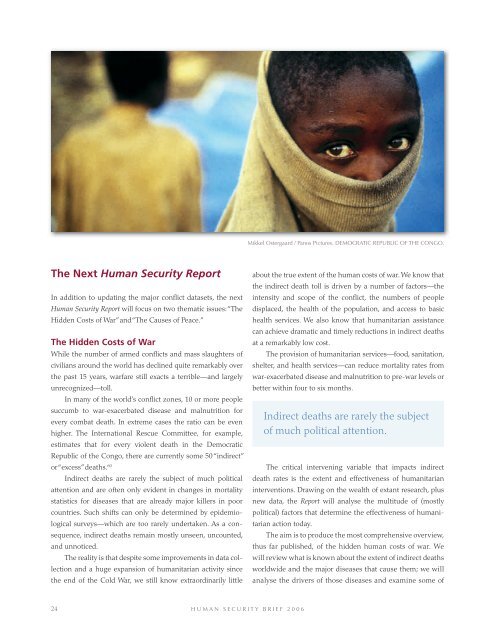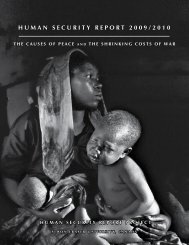Mikkel Ostergaard / Panos Pictures. DEMOCRATIC REPUBLIC OF THE CONGO.The Next Human Security ReportIn addition to updating the major conflict datasets, the nextHuman Security Report will focus on two thematic issues: “TheHidden Costs of War” and “The Causes of Peace.”The Hidden Costs of WarWhile the number of armed conflicts and mass slaughters ofcivilians around the world has declined quite remarkably overthe past 15 years, warfare still exacts a terrible—and largelyunrecognized—toll.In many of the world’s conflict zones, 10 or more peoplesuccumb to war-exacerbated disease and malnutrition forevery combat death. In extreme cases the ratio can be evenhigher. The International Rescue Committee, for example,estimates that for every violent death in the DemocraticRepublic of the Congo, there are currently some 50 “indirect”or “excess” deaths. 60Indirect deaths are rarely the subject of much politicalattention and are often only evident in changes in mortalitystatistics for diseases that are already major killers in poorcountries. Such shifts can only be determined by epidemiologicalsurveys—which are too rarely undertaken. As a consequence,indirect deaths remain mostly unseen, uncounted,and unnoticed.The reality is that despite some improvements in data collectionand a huge expansion of humanitarian activity sincethe end of the Cold War, we still know extraordinarily littleabout the true extent of the human costs of war. We know thatthe indirect death toll is driven by a number of factors—theintensity and scope of the conflict, the numbers of peopledisplaced, the health of the population, and access to basichealth services. We also know that humanitarian assistancecan achieve dramatic and timely reductions in indirect deathsat a remarkably low cost.The provision of humanitarian services—food, sanitation,shelter, and health services—can reduce mortality rates fromwar-exacerbated disease and malnutrition to pre-war levels orbetter within four to six months.Indirect deaths are rarely the subjectof much political attention.The critical intervening variable that impacts indirectdeath rates is the extent and effectiveness of humanitarianinterventions. Drawing on the wealth of extant research, plusnew data, the Report will analyse the multitude of (mostlypolitical) factors that determine the effectiveness of humanitarianaction today.The aim is to produce the most comprehensive overview,thus far published, of the hidden human costs of war. Wewill review what is known about the extent of indirect deathsworldwide and the major diseases that cause them; we willanalyse the drivers of those diseases and examine some of24H U M A N S E C U R I T Y B R I E F 2 0 0 6
the key dilemmas and constraints that confront humanitarianand local actors as they seek to help reduce conflictinducedsuffering.The Causes of PeaceThe “Causes of Peace” section will offer a more in-depth analysisof the arguments made briefly in Part V of the 2005 HumanSecurity Report. It will provide an accessible account of what isknown about the drivers of peace in today’s most numerousand deadly conflicts—civil wars in poor countries.This section will critically review key findings aboutthe causes of peace from the conflict research literature,commissioning new research where necessary. It will compareexplanations that stress structural factors (“root causes”) andevents data with those that focus on policies that seek toreduce the risk and incidence of war. The latter include whatthe UN calls “peacemaking” and “peacebuilding,” but alsopolicies that seek to stop existing wars and deter new ones bycoercive means.It will also include detailed analyses of the many innovativesecurity initiatives that have become standard security practicesince the early 1990s—from the proliferation of “Friends”groups to the entrenchment of disarmament, demobilization,and reintegration programs in peace operations.Explanations for declining political violence that stressthe importance of security policies stand in sharp contrast tothe academic research that sees the drivers of peace as theinverse of the causes of war. In the latter case researchers usemultiple regression analysis to determine whether, and towhat extent, “structural” factors—such as income per capita,“youth bulges,” trade openness, “horizontal inequality,” anddependence on primary commodities—affect the risk andincidence of armed conflict.The assumption that flows naturally from this work is thatthe drivers of peace are the antithesis of the drivers of war.There is in fact considerable evidence to support this assumption.For example, as incomes (and thus state capacity) riseand as economies diversify, state capacity increases, politicalinstability decreases, group inequalities are attenuated, andthe risk of civil war declines. Where the reverse is true, the riskof war increases. These sorts of structural changes helped drivethe decline in armed conflicts in East and Southeast Asia thatbegan in the 1970s as local economies boomed and democratizationspread across the region. This decline has continuedto the present day.However, as the 2005 Human Security Report argued, thedramatic worldwide downturn in political violence that hasoccurred since the early 1990s cannot be explained by changesin structural factors like income per capita or rates of economicgrowth. Structural change simply has not been significant orwidespread enough to explain the steepness of the decline inarmed conflicts.The case of sub-Saharan Africa is instructive here.Between 2003 and 2005 the number of low-income countriesunder stress had increased from 11 to 14. 61 Over the sameperiod the number of armed conflicts (including intercommunalconflicts) had declined by an extraordinary 37%—from 30to 19. Here the most compelling explanation for the declineappears to lie with the greatly expanded conflict prevention,peacemaking, and peacebuilding policies pursued by theinternational community during this period.Drawing on a range of recent empirical research, we willalso analyse the effectiveness of a range of coercive policiesthat have been employed by the international community inpursuit of security goals. These include sanctions, economicconditionality instruments, and military interventions. An initialreview of the literature suggests that, with some exceptions,the success rate of coercive approaches is very low.The section will contain an accessible guide to thestrengths and weaknesses of different approaches to explainingthe causes of peace—from macroquantitative econometricanalysis to case studies.Unpacking the reasons why wars come to an end—or insome countries never start—is a complex and often contestedtask. In addressing it, the next Report is responding to theincreasing insistence by donor governments, agencies, andmajor NGOs that humanitarian, peacebuilding, and conflictprevention policies be evidence-based.H U M A N S E C U R I T Y B R I E F 2 0 0 6 25






